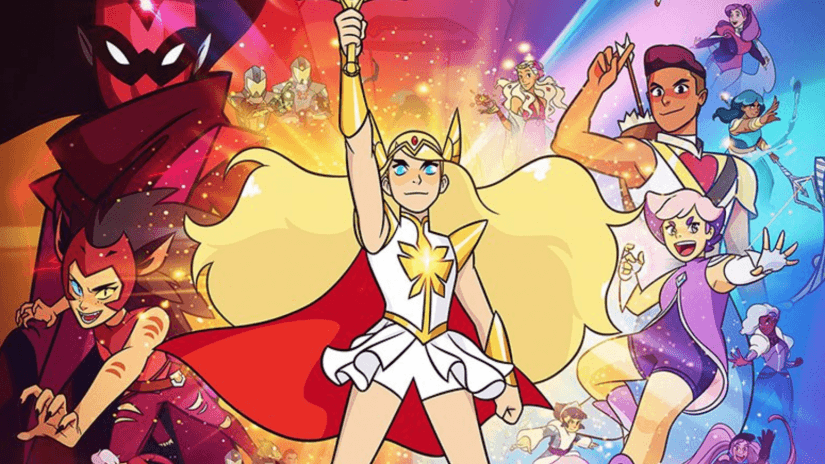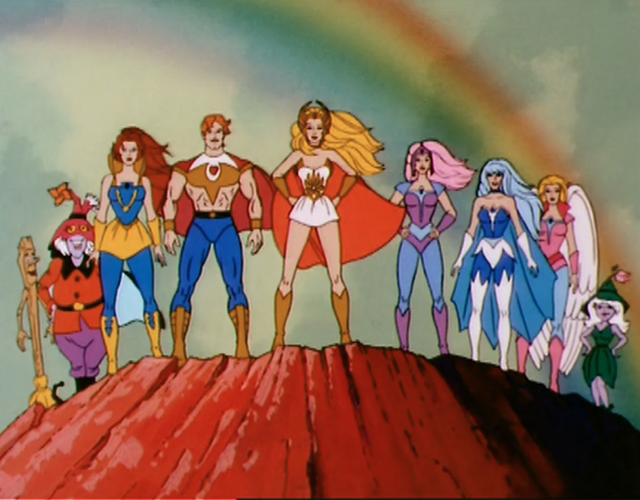I would classify myself as a kidult. I’m a 41-year-old father with two kids and I think this show is rad. She-Ra rides her winged horse deftly between the line of genuinely optimistic and subversively sinister. While She-Ra and the Princesses of Power is geared toward children, it has very subtle and serious character relationships, far more realistic and traumatic than any animated show I’ve seen in a while.
Those born in the ’80s may be familiar with She-Ra, the female equivalent to He-Man, the muscular toy and cartoon phenomenon. Both characters came at a time of deregulation of advertising in children’s television, prompting the way for cartoons to be created to sell their toy lines. 1983 brought He-Man and the Masters of the Universe and in 1985, She-Ra: Princess of Power was created to sell Mattel’s similar line of action figures as dolls to young girls. The product came first, rather than story, and those classics from my youth have little depth when viewed with an adult eye. I did not watch She-Ra as a kid, so I don’t have any nostalgic bias toward the original, but I am familiar with her and the old He-Man cartoon. In casting a younger She-Ra, the new series has grown up substantially.
The show immediately strays from the original, in that the characters are all children. Adora is 16 years old, a rising star within the “evil” Horde military. She’s a type-A personality, completing her drills by the book. She’s trained her whole life to become a Force Captain for the Horde, along with her humanoid-feline best friend, Catra. Adora is called to a magical sword in the forest and discovers she can transform into She-Ra, a super strong Valkyrie-like hero with mythic power, who has not been seen in nearly 1,000 years. It’s then she realizes she’s been lied to by the Horde, and that the order they are enforcing is the murder and destruction of everyone else.
It’s a refreshing change of tone, as the ’80s version featured an adult Adora / She-Ra. Most times, those old cartoons felt as if children were inhabiting the bodies of adult heroes, like children play-acting as adults, where the new series feels like teenagers struggling to accept their roles as young leaders. Both Adora and Catra have to navigate typical teenage problems, whether it be trying to do their best in their training or maintaining relationships within the Horde academy. The show is smart with its dialogue, as well as its voice acting. The characters talk like a modern teenage child without resorting to cartoony voices. Each character, from the main ones to the bit players, struggles with either trying to destroy the rebellion as members of the Horde or avoiding the Horde’s devastating hand.
Another thing that struck me is the diversity in the characters. Characters represent all races and body types. Gone is the “Heavy Metal” ’70s side of the van airbrushed swords and sorcery Barbie doll-like bodies. She-Ra, herself, has been redesigned with a more athletic look, focusing on functionality rather than ornamentation. Her original cleavage-showing dress is covered up and includes athletic shorts and functional boots, rather than high heels.
I was pleasantly surprised to see unique characters with regular body types. Glimmer, one of the good princesses, is short and stocky. Her best friend, Bow, is a teenage boy of color. The other princesses display various skin tones or ethnic backgrounds. No character has an impossible-to-achieve body image.
There is plenty of discussion online about the homosexual aspects of some of the characters. I am no expert in such matters and would only comment from a position of ignorance, but I highly recommend other writers’ takes on the issue.
The show balances many storytelling elements in the right amounts to feel genuine. It mixes equal parts optimism with equal parts darkness. Heavy emotional trauma is side by side with absurd situations, and by absurd I mean a talking horse. But the realistic way in which the show addresses both the fight against the Horde and the struggles each character has within themselves makes the show shine. Any child should be able to find themselves within the cast of characters.
The dynamic between Adora and Catra is the best ongoing plot in the series. The duo grew up together in the Horde and trained under their commander / mother figure named Shadow Weaver. Adora had always protected Catra from Catra’s own rule-breaking behaviors. The two are best friends whose friendship is strained and tested as they follow the path they believe is best for themselves and their world. I haven’t seen a more sympathetic and relatable antagonist in Catra since the relationship between the X-Men’s Charles Xavier and Magneto. I’m careful to use the term antagonist, as she’s not a villain. She doesn’t do evil for evil’s sake. She is more than a foil to Adora too, as the series explores Catra’s feelings of inadequacy and abandonment or her resolution in spite of the emotional abuse she’s suffered from Shadow Weaver. These nuances make the show compelling to an adult and probably will go over the heads of a younger audience.
What hit me the hardest is the character of Shadow Weaver, the Horde’s sorceress who took in Adora and Catra as babies and raised them to be killing machines. There is a twisted, abusive love between Shadow Weaver and Adora. It’s as if any time Shadow Weaver tries to show praise or affections, it comes off being derisive and manipulative. Clearly she favors Adora over Catra, and says and does terrible things to Catra over the course of the series. Catra responds like an abused child, whose reality has been a constant state of fight or flight and emotional trauma. This vileness to children is equaled by the genocide of the Horde. While the killings are never fully shown, it is significantly hinted at.
My 6-year-old daughter watched the new She-Ra. She likes it, not as much as the originals she watched with her mother, but she enjoys it. This version of She-Ra is the show I want for my kids. This isn’t a 22-minute commercial for a toy line inadvertently promoting an unrealistic body image. She-Ra and the others, including the Horde, are complex characters who struggle with themselves and their friendships in the midst of a war. They not only look like regular teenagers, they act like them too. More than what my kids want, it’s what this dad wants for his kids, and I can enjoy it also.

